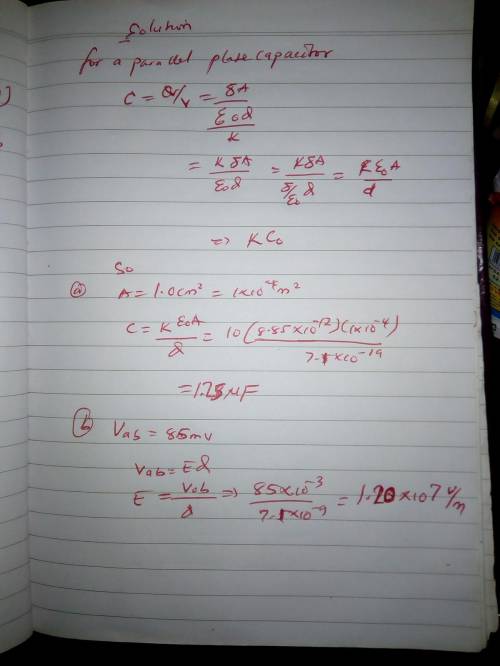
Physics, 21.07.2020 16:01 mooreadrian41235
Cell membranes (the walled enclosure around a cell) are typically about d = 7.1 nm thick. They are partially permeable to allow charged material to pass in and out, as needed. Equal but opposite charge densities build up on the inside and outside faces of such a membrane, and these charges prevent additional charges from passing through the cell wall. We can model a cell membrane as a parallel-plate capacitor, with the membrane itself containing proteins embedded in an organic material to give the membrane a dielectric constant of about 12.
Required:
a. What is the capacitance per square centimeter of such a cell wall?
b. In its normal resting state, a cell has a potential difference of 85mV across its membrane. What is the electric field inside this membrane?

Answers: 2


Another question on Physics

Physics, 22.06.2019 06:00
The magnetic field inside a superconducting solenoid is 4.50 t. the solenoid has an inner diameter of 6.20 cm and a length of 26.0 cm. determine (a) the magnetic energy density in the field and (b) the energy stored in the magnetic field within the solenoid.
Answers: 2

Physics, 22.06.2019 06:00
What are atoms of the same element with varying number of neutrons
Answers: 3

Physics, 22.06.2019 07:50
Determine the fraction of the magnitude of kinetic energy lost by a neutron (m1 = 1.01 u) when it collides head-on and elastically with a target particle at rest which is 21h (heavy hydrogen, m = 2.01 u).
Answers: 3

Physics, 22.06.2019 14:20
A1-lb collar is attached to a spring and slides without friction along a circular rod in a vertical plane. the spring has an undeformed length of 5 in. and a constant k =25 lb/ft. knowing that the collar is released from being held at a determine, the speed of the collar and the normal force between the collar and the rod as the collar passes through b.
Answers: 3
You know the right answer?
Cell membranes (the walled enclosure around a cell) are typically about d = 7.1 nm thick. They are p...
Questions


Mathematics, 31.07.2019 00:00

Physics, 31.07.2019 00:00

Social Studies, 31.07.2019 00:00







Mathematics, 31.07.2019 00:00







Mathematics, 31.07.2019 00:00

Health, 31.07.2019 00:00

English, 31.07.2019 00:00




